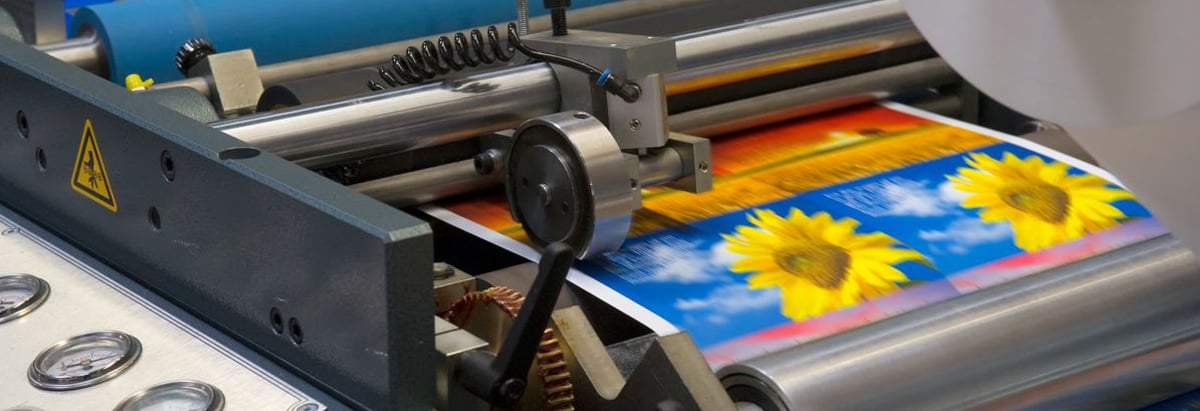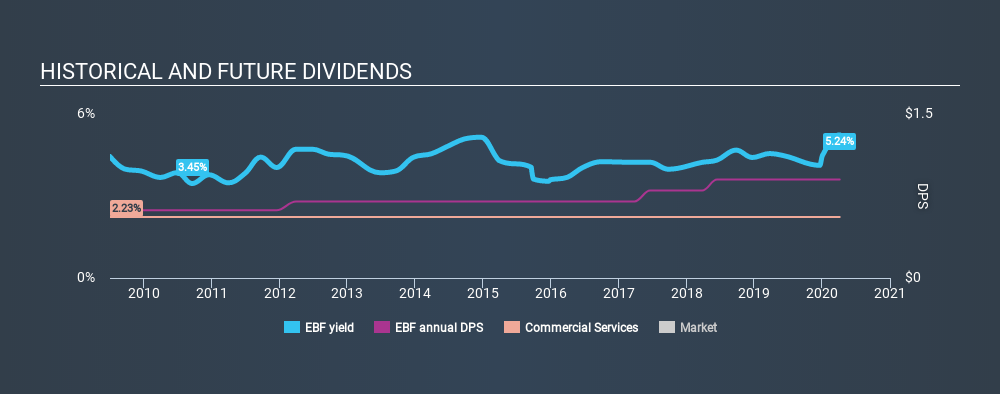Stock Analysis
- United States
- /
- Commercial Services
- /
- NYSE:EBF
Ennis, Inc.'s (NYSE:EBF) Could Be A Buy For Its Upcoming Dividend

Regular readers will know that we love our dividends at Simply Wall St, which is why it's exciting to see Ennis, Inc. (NYSE:EBF) is about to trade ex-dividend in the next 3 days. Investors can purchase shares before the 9th of April in order to be eligible for this dividend, which will be paid on the 4th of May.
Ennis's next dividend payment will be US$0.23 per share, and in the last 12 months, the company paid a total of US$0.90 per share. Looking at the last 12 months of distributions, Ennis has a trailing yield of approximately 5.2% on its current stock price of $17.19. Dividends are an important source of income to many shareholders, but the health of the business is crucial to maintaining those dividends. So we need to check whether the dividend payments are covered, and if earnings are growing.
See our latest analysis for Ennis
Dividends are typically paid from company earnings. If a company pays more in dividends than it earned in profit, then the dividend could be unsustainable. Ennis paid out 62% of its earnings to investors last year, a normal payout level for most businesses. Yet cash flow is typically more important than profit for assessing dividend sustainability, so we should always check if the company generated enough cash to afford its dividend. Thankfully its dividend payments took up just 42% of the free cash flow it generated, which is a comfortable payout ratio.
It's encouraging to see that the dividend is covered by both profit and cash flow. This generally suggests the dividend is sustainable, as long as earnings don't drop precipitously.
Click here to see how much of its profit Ennis paid out over the last 12 months.

Have Earnings And Dividends Been Growing?
Companies with consistently growing earnings per share generally make the best dividend stocks, as they usually find it easier to grow dividends per share. If earnings fall far enough, the company could be forced to cut its dividend. That's why it's comforting to see Ennis's earnings have been skyrocketing, up 24% per annum for the past five years. The current payout ratio suggests a good balance between rewarding shareholders with dividends, and reinvesting in growth. With a reasonable payout ratio, profits being reinvested, and some earnings growth, Ennis could have strong prospects for future increases to the dividend.
Many investors will assess a company's dividend performance by evaluating how much the dividend payments have changed over time. In the last ten years, Ennis has lifted its dividend by approximately 3.8% a year on average. It's good to see both earnings and the dividend have improved - although the former has been rising much quicker than the latter, possibly due to the company reinvesting more of its profits in growth.
Final Takeaway
Is Ennis an attractive dividend stock, or better left on the shelf? Ennis's growing earnings per share and conservative payout ratios make for a decent combination. We also like that it paid out a lower percentage of its cash flow. Ennis looks solid on this analysis overall, and we'd definitely consider investigating it more closely.
With that in mind, a critical part of thorough stock research is being aware of any risks that stock currently faces. Every company has risks, and we've spotted 1 warning sign for Ennis you should know about.
A common investment mistake is buying the first interesting stock you see. Here you can find a list of promising dividend stocks with a greater than 2% yield and an upcoming dividend.
If you spot an error that warrants correction, please contact the editor at editorial-team@simplywallst.com. This article by Simply Wall St is general in nature. It does not constitute a recommendation to buy or sell any stock, and does not take account of your objectives, or your financial situation. Simply Wall St has no position in the stocks mentioned.
We aim to bring you long-term focused research analysis driven by fundamental data. Note that our analysis may not factor in the latest price-sensitive company announcements or qualitative material. Thank you for reading.
About NYSE:EBF
Ennis
Manufactures and sells business forms and other business products in the United States.
Flawless balance sheet established dividend payer.

